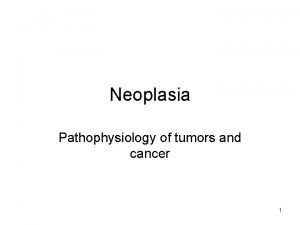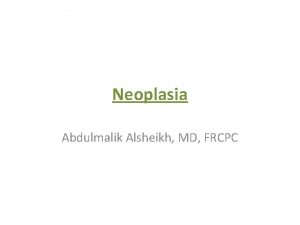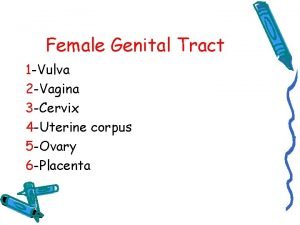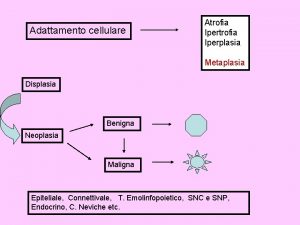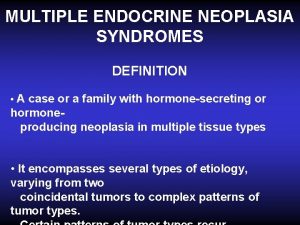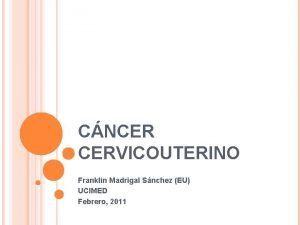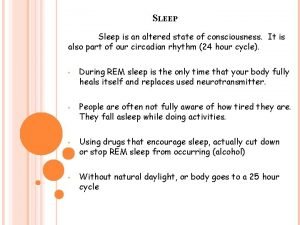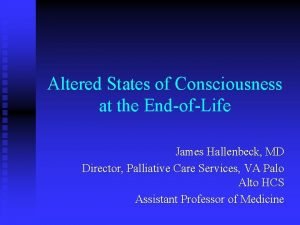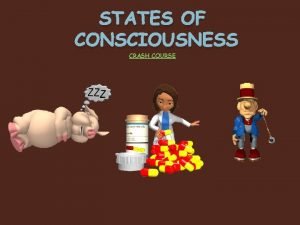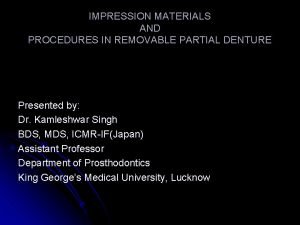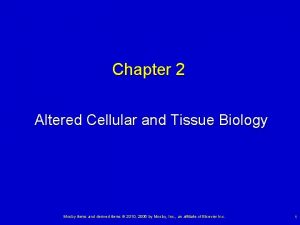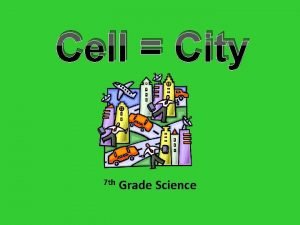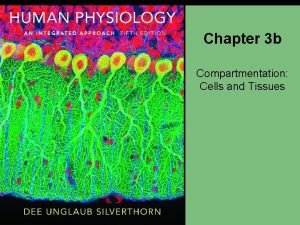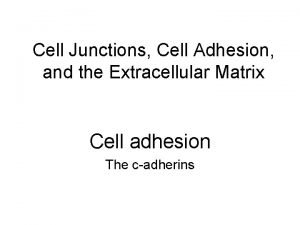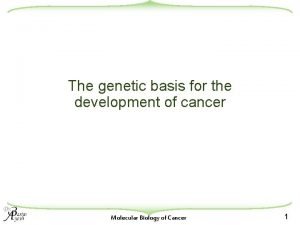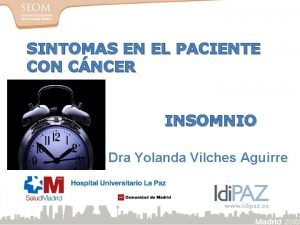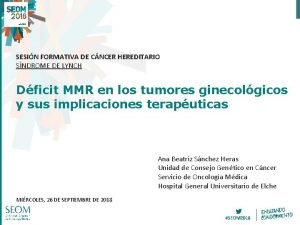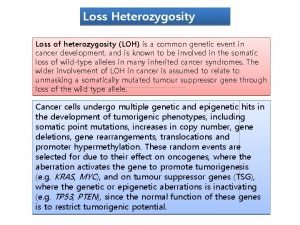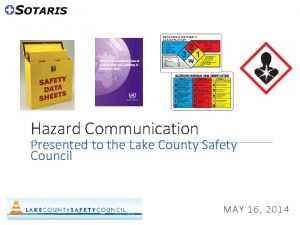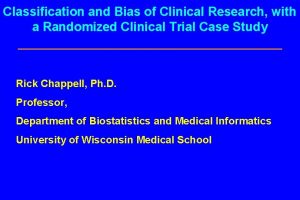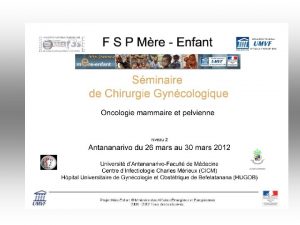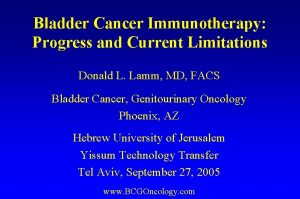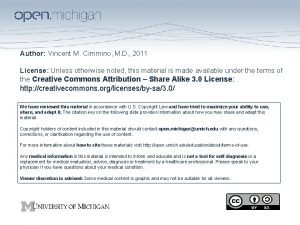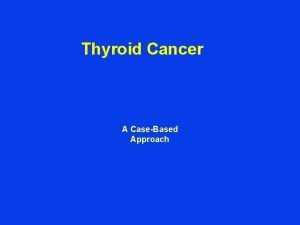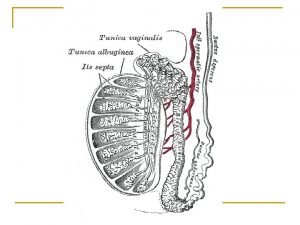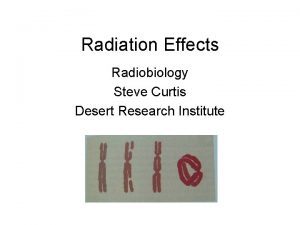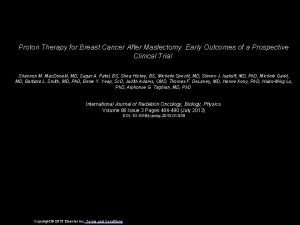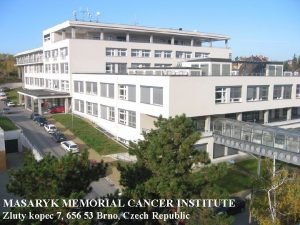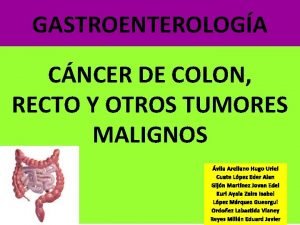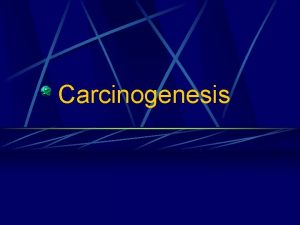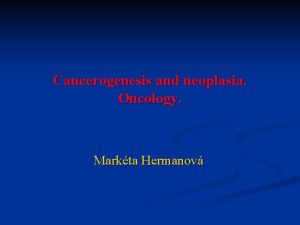Neoplasia Cancer Neoplasia A Disorder of Altered Cell

















































































































































- Slides: 145

Neoplasia Cancer

Neoplasia A Disorder of Altered Cell Differentiation and Growth

Cancer • The second leading cause of death in the United States – Estimated 1. 45 million diagnosed – 559, 650 die each year • Prostate is the most common cancer for men • Breast is the most common cancer for women – Excluding skin cancer • Lung cancer is the leading cause of death in both men and women


Definitions • Benign – not capable of metastasizing and usually not capable of causing death • Malignant – capable of metastasizing and capable of causing death • Neoplasm – an uncontrolled growth of new cells, benign or malignant • Tumor – literally, a mass; however, in everyday language, a neoplasm • Cancer – any kind of malignant neoplasm • Carcinoma – a malignant neoplasm of epithelial cells • Sarcoma – a malignant neoplasm of mesenchymal cells

Growth Layers

More Definitions • -oma is used for benign tumors – There is a matching malignant variety for every benign variety – For example, adenoma – aden = gland oma = swelling • A benign tumor of fibrous tissue is a fibroma

Even More Definitions • Malignant tumors are named by adding carcinoma if the tumor is of epithelial origin – Breast duct epithelium, prostate epithelium, bronchial epithelium and so on • Sarcoma if the tumor is from mesenchymal tissue – Bone, cartilage, fat, muscle or fibrous tissue • Adenocarcinoma if the tumor is of glandular epithelial cells • Fibrosarcoma if the tumor

Mutations • The root cause of all cancer is damaged (mutant) DNA • This causes the normal cycle of cellular reproduction to go awry

Cell Cycle • Cell proliferation – – Process of cell division Inherent adaptive mechanism for replacing body cells • Sequence of events that occurs as a cell duplicates – Genetic information is also duplicated – • Duplicated chromosomes are appropriately aligned for distribution between two genetically identical daughter cells Process of specialization

http: //highered. mcgrawhill. com/sites/9834092339/student_view 0/cha pter 10/control_of_the_cell_cycle. html


Interphase • G 1 (gap 1) – From the end of the M phase until the beginning of DNA synthesis – Growth Phase – The cell determines its readiness to commit to DNA synthesis • S (DNA Synthesis) – DNA replication • G 2 (gap 2) – DNA replication is assessed and errors are corrected – the gap between DNA synthesis and mitosis, the cell will continue to grow.

Cell Cycle • M-Phase (Mitotic Phase) – The replicated chromosomes are separated and packaged into two new nuclei by mitosis – The cytoplasm is divided between the two daughter cells by cytokinesis – Prophase – Metaphase – Anaphase – Telophase

• http: //highered. mcgrawhill. com/sites/9834092339/student_view 0/ch apter 10/stimulation_of_cell_replication. html

Cyclins and CDK’s • Two key classes of regulatory proteins, Cyclins and Cylin-Dependent Kinases (CDKs), determine a cell’s progress through the cell’s cycle

Cell Cycle • Cyclins are proteins that control the entry and progression of cells through the cell cycle • Cyclins bind to cyclin-dependent kinases (CDK), which are enzymes that phosphorylate proteins • Cyclin-dependent kinase inhibitorsregulates cell cycle checkpoints to prevent DNA replication mistakes.

Cyclins and CDK’s • Progression from one phase of the cell cycle to the next is controlled by the orderly activation of cyclin dependent kinases • Cyclin proteins bind to CDK’s to cause phosphorylation and activation

• http: //highered. mcgrawhill. com/sites/9834092339/student_view 0/chapter 1 0/how_tumor_suppressor_genes_block_cell_divisio n. html

Cell Growth Control Genes • All cells contain genes that function as “go” or “stop” switches (restrains cell growth) • The “go” genes are proto-oncogenes • Proto-oncogenes produce growthpromoting proteins that stimulate normal cell division • Oncogenes (cancer genes) come from mutations of proto-oncogenes – Their function is to stimulate uncontrolled cellular division

Tumor Suppressor Genes • “stop” genes are the opposite of protooncogenes – Called Tumor suppressor genes • Produce proteins that inhibit cell division – Mutation of tumor suppressor genes leaves cell growth uninhibited

http: //highered. mcgrawhill. com/sites/9834092339/student_view 0/chapter 9/cell_proliferation_signaling_p athway. html

Tumor Suppressor Genes • Retinoblastoma is a rare childhood cancer due to the inactivation of a specific tumor suppressor gene • Retinoblastoma (p. RB) gene • Prevents cell division – Retinoblastoma tumor suppressor protein (p. RB) • Phosphorylation of p. RB causes progression of the cell into the S-phase – A point mutation renders the p. RB pathway non -functional • Thought to occur in almost all human cancers

Tumor Suppressor Genes • p 53 gene • Found on the small arm of chromosome 17 • Its protein product is in virtually all normal tissues • Controls p 53 protein levels • p 53 proteins increase with damage to DNA • Initiates apoptosis of DNAdamaged cells

p 53 Gene • “Guardian of the genome” – Restricts uncontrolled cellular proliferation under circumstances in which cells with abnormal DNA might propagate • Deleted or mutated in 70% to 80% of cases of colorectal cancer, breast cancer, small cell carcinoma of the lung, hepatocellular carcinoma, astrocytoma and numerous other tumors


Epigenetics • Involves changes of gene expression without a change in the DNA – “silence” genes such as tumor suppressor genes – Methylation of the promoter region • Prevents transcription to cause gene inactivity • Can be inherited

Genetic and Molecular Basis of Cancer • Epigenetic factors • http: //youtu. be/Xjq 5 e. Esl. Jhw • http: //youtu. be/w. Fsx. Vku. Chd. U

The Spread of Neoplasms • Direct invasion and extension • Seeding of cancer cells in body cavities • Metastases

Premalignant States and Conditions • Neoplasms evolve over time from normal tissue • Dysplasia – A pre-malignant state of tissue that is atypical and clearly abnormal but not yet malignant – Dysplasia does NOT always progress to malignancy • Carcinoma in situ – Cancer that never metastasizes







Invasion • Cancer is latin for crablike – Cancer grows by sending crablike projections into the surrounding tissues • Cancers secrete enzymes to break down proteins to increase invasion and penetration of surrounding tissues – Prevents sharp demarcation for surgical removal

Seeding • A tumor erodes and shed cells into body cavities – Peritoneal, pleural, pericardial cavity and joint spaces • Floating in body space from one surface to another • These cancers grow in masses and secrete fluids – Ascites, pleural effusion


Metastasis • The ability to skip from one place to another – Via lymphatics or the bloodstream • Breast via lymphatics to lymph nodes • Via blood to bone – Metastases may occur by seeding

Metastasis


Nourishment of Tumors • Angiogenesis – Neoplasms develop their own blood supply


Liver Metastasis



Human Papilloma Virus • Infection in the cervix – Causes dysplasia, carcinoma in situ and invasive carcinoma – Takes many years and repeated infections to produce dysplasia or malignancy


Grading and Staging of Malignancies • Cancer Grading – Microscopic assessment of the degree of differentiation, atypia and other features of malignancy • Cancer Staging – Evaluation of behavior by assessing size of the primary tumor and its spread • Assessed by physical exam, history and pathologic and diagnostic imaging

Grade • III • IV Definition Well differentiated Moderately differentiate Poorly differentiated Nearly anaplastic (cells that have become less differentiated)



Staging • TNM classification. – A "T" score is based upon the size and/or extent of invasion. – The "N" score indicates the extent of lymph node involvement. – The "M" score indicates whether distant metastases are present.


Stage Definition Tis T 1 T 2 In situ, non-invasive (confined to epithelium) Small, minimally invasive within primary organ site Larger, more invasive within the primary organ site T 3 Larger and/or invasive beyond margins of primary organ site T 4 Very large and/or very invasive, spread to adjacent organs N 0 No lymph node involvement N 1 Nearby lymph node involvement N 2 Regional lymph node involvement N 3 More distant lymph node involvement M 0 No distant metastases M 1 Distant metastases present


Benign v Malignant Tumors

BENIGN VERSUS MALIGNANT TUMORS Benign Tumors Do not penetrate (invade) adjacent tissue Do no spread (metastasize) to different sites. Malignant Tumors Invades contiguous tissues Metastasizes to distant sites Takes up residence, grows and invades again

BENIGN VERSUS MALIGNANT TUMORS • BENIGN – Malignant tumors kill – Benign tumors don’t kill (mostly) • Benign intracranial tumor in the meninges (meningioma) can kill by exerting pressure on the brain • Benign mesenchymal tumor of the left atrium (myxoma) can kill by blocking the orifice of the mitral valve

Benign Tumors • The primary descriptor of any tumor, benign or malignant is its cell or tissue of origin. • Benign tumors are identified by the suffix “oma” which is preceded by reference to the cell or tissue of origin – Chondroma, resembles chondrocytes – Epithelioma, tumor of squamous cells – Adenoma, arising from glandular epithelium such as in the colon or endocrine glands

Types of Tumors • Adenoma: benign tumor of glandular epithelial tissue • Adenocarcinoma: malignant tumor of glandular epithelial tissue • Carcinoma: malignant tumor of epithelial tissue • Osteoma: benign tumor of bone tissue • Sarcoma: malignant tumors of mesenchymal origin • Papilloma: benign microscopic or macroscopic fingerlike projection growing on a surface

Histologic Diagnosis of Benign Tumors • Benign tumors in general resemble their parent tissues both histologically and cytologically • The lining epithelium may resemble that of the normal tissue – May be surrounded by a connective tissue capsule (or not)






Normal Cartilage

Benign Chondroma

Normal Thyroid Tissue

Benign Thyroid Adenoma

Lung Hemartoma

Malignant Tumors • Malignant tumors usually carry the same name, except the suffix “carcinoma” is applied to epithelial cancers and “sarcoma” to mesenchymal cancers • Gastric adenocarcinoma – Malignant tumor of the stomach • Squamous cell carcinoma – An invasive tumor of the skin • Transitional cell carcinoma – Malignant neoplasm of the bladder

Characteristics of Malignant Neoplasms • Tend to grow rapidly • Invades and infiltrates nearby tissue • Spreads widely • Lack of defined capsule • Margins are not clearly separated from normal surrounding tissue • Have the potential to kill regardless of their original location

Characteristics of Malignant Neoplasm • Tends to compress blood vessels and outgrow their blood supply, causing ischemia and tissue necrosis • Robs normal tissues of essential nutrients • Secretes hormones and/or cytokines, liberates enzymes and toxins that destroy tumor tissue and normal tissue

Historically Important Hepatoma of the liver Melanoma of the skin Seminoma of the tesis Lymphoma or lymphoproliferation tumor are all highly malignant • “emia” – relationship with the blood • • – Leukemia

Histologic Diagnosis of Malignant Tumors • In Malignant tumors cells have a different structure than the parent tissue and they take on a different function – Anaplasia • Loss of differentiation of cells and of their orientation to one another – Lack of differentiated features in a cancer cell – The degree of anaplasia correlates with the aggressiveness of the tumor – Mitotic Activity – Invasion – Metastases

Anaplasia 1. Variation in the size and shape of cells and cell nuclei (pleomorphism) 2. Enlarged and hyperchromatic nuclei with coarsely clumped chromatin and prominent nucleoli 3. Atypical mitoses 4. Bizarre cells




Mitotic Activity • Abundant mitoses are characteristic of many malignant tumors but are not a necessary criterion


Invasion • Invasion, particularly of blood vessels and lymphatics














Squamous Cell Carcinoma of the Skin



Malignant v Benign Characteristics Benign Malignant Tissue differentiation Well differentiated, structure fairly close to tissue of origin Poorly differentiated; little structure resemblance to tissue of origin Nuclear atypia Minimal atypia; nuclei small and uniform Substantial atypia; nuclei large, dark, irregular (hyperchromatism) Local Growth Slow growth; cut surface uniform; regular expansion compresses surrounding tissue into fibrous capsule Rapid growth; cut surface variegated; irregular growth at margins; infiltration of adjacent tissue Metastasis None Frequent

Cancer Treatment Modalities • Radiation • Can be used as a primary method of therapy or as an adjuvant treatment with surgery and/or chemotherapy • Uses high-energy particles or waves to destroy or damage cancer cells • Absorption of energy from radiation in tissue leads to the ionization of molecules or creation of free radicals • Can kill cells, halt cell proliferation or cause damage to cell’s DNA resulting in cellular death • Can be injurious to other cells

Administration of Radiation • 3 Ways – External beam or teletherapy • Beams generated at a distance and aimed at the tumor – Brachytherapy • Sealed radioactive source is placed close to or directly in the tumor site – Systemic therapy • Radioisotopes with a short half-life are given by mouth or injected into the tumor site

Chemotherapy • Systemic treatment that enables drugs to reach the site of the tumor as well as other distant sites – Direct DNA-interacting – Damages DNA or block cellular division – Hair loss or alopecia – Indirect DNA-interacting – Interrupts biochemical pathways relating to nucleotide and nucleic acid synthesis = No DNA – Toxic to all cells =Handler beware

Cancer Treatment Modalities • Hormonal therapy • Drugs designed to disrupt the hormonal environment of cancer cells • Used for Cancers that are responsive to hormones for growth • Biotherapy – Immunotherapy – Monoclonal Antibodies – Biologic response – Interferons – Stimulate NK cells and T-lymphocytes – Targeted Therapy – Small molecules that block specific enzymes and growth factors

Types of Surgery for Cancer • Cryosurgery: instilling liquid nitrogen into the tumor through a probe • Chemosurgery: using corrosive paste with multiple frozen sections to ensure complete removal of tumor • Laser surgery: using a laser beam to resect tumor • Laparoscopic surgery: performing surgery through two small incisions

Stem Cell Transplantation Bone marrow transplantation (BMT) Peripheral blood stem cell transplantation (PBSCT) Two treatment approaches for individuals with leukemias, certain solid tumors, and other cancers previously thought to be incurable

Clinical Manifestations of Cancer • Tissue integrity – Compressed and eroded blood vessels, ulceration and necrosis, frank bleeding, and hemorrhage • Cancer cachexia – Weight loss and wasting of body fat and muscle tissue; profound weakness, anorexia, and anemia

Clinical Manifestations of Cancer • Paraneoplastic syndromes – Inappropriate hormone release, circulating hematopoietic, neurologic, and dermatologic factors – Not directly at the site of the cancer • Cancer may cause Cushing syndrome due to ectopic ACTH production and hypercalcemia • Lambert-Eaton myasthenic syndrome

Host and Environmental Factors Leading to Cancer • Stem cells • Heredity • Hormones • Angiogenesis • Carcinogens – Angiogenic factor Chemical production or loss of angiogenic inhibitors Radiation • Oncogenic viruses • Microenvironmental effects • Immunologic mechanisms – Multiple cell types, cytokines, and growth factors

Heredity • BRCA 1 and BRCA 2 – Tumor Suppressor genes – Mutation to become Oncogene – Implicated in the risk of breast, ovarian, pancreatic, colon and other cancers

Immune System • Immune Surveillance Hypothesis – Cancers may be associated with the decline of surveillance ability – Tumor Antigens on cancer cells stimulate the immune response • Immunosuppression may lead to cancer

Chemical Carcinogens • Sir Percivall Pott, 1775 – First to relate the high incidence of scrotal cancer in chimney sweeps – Ruled that chimney sweeps must bathe daily • Many chemicals can cause cellular mutations – Carcinogenic Chemicals – Food Fried in Fat that is Re-Used – Smoked or BBQ meats – Dose dependent

Radiation • Ionizing radiation – Depends on the dose of radiation – Hiroshima and Nagasaki • Ultraviolet radiation – Skin cancer

Oncogenic Viruses • Epstein-Barr virus – Herpes virus – Burkitt lymphoma (B-cell lymphoma) • Hepatitis B virus – Hepatocellular carcinoma (liver cancer) • Human Herpes virus 8 – Kaposi Sarcoma in AIDS • Human Papilloma Virus (60 types) – Squamous Cell Carcinoma of the Cervix

Diagnostic Measures for Cancer Detection • Lab tests – Pap smear – Biopsy – Immunohistochemistry and tissue biopsy – Microarray Technology – Endoscopic examinations – Ultrasound – X-ray studies, MRI – CT and PET • Staging and grading of tumors • Grades I, III, and IV • Level of differentiation • Screening for early detection – Observation – Palpation – Laboratory tests

Diagnostic Measures for Cancer Detection • Tumor markers – Antigens expressed on the surface of tumor cells – Substances released from normal cells in response to the presence of a tumor – Used for screening for cancer • • h. CG PSA α-Fetoprotein (AFP) May express fetal antigens normally present only in embryonic development

Question Which of the following does not apply to benign tumor cells? A. A slow, progressive rate of growth that may come to a standstill or regress B. An expansive manner of growth C. Liberation of enzymes and toxins that destroy tumor tissue and normal tissue D. Composed of well-differentiated cells that resemble the cells of the tissue of origin

Answer Which of the following does not apply to benign tumor cells? A. A slow, progressive rate of growth that may come to a standstill or regress B. An expansive manner of growth C. Liberation of enzymes and toxins that destroy tumor tissue and normal tissue D. Composed of well-differentiated cells that resemble the cells of the tissue of origin

Goals of Cancer Treatment • Curative • Control • Palliative care is the active total care of the one's body, mind and spirit, and also involves giving support to the family

• http: //cancerhelp. cancerresearchuk. org/about -cancer/what-is-cancer/

Common Solid Tumors of Childhood • Brain and nervous system tumors • Neuroblastoma • Wilms tumor • Rhabdomyosarcoma and embryonal sarcoma • Retinoblastoma • Osteosarcoma • Ewing sarcoma

Characteristics of Childhood Cancers • Most involve the hematopoietic system, nervous system, or connective tissue • Heritable forms of cancer tend to have – An earlier age of onset – A higher frequency of multifocal lesions in a single organ – Bilateral involvement of paired organs or multiple primary tumors

Question Is the following statement true or false? Radiation is a common treatment for childhood cancers. A. True B. False

Question Is the following statement true or false? Radiation is a common treatment for childhood cancers. A. True B. False: Radiation will have long-lasting effects, whereas other methods of treatment are not as damaging.


p 53 • Acquired mutation in p 53 is the most common genetic alteration found in human cancer – One p 53 allele may be deleted while the other is mutated • Therapies are directed at re-establishing the p 53 genes to cause massive apoptosis of cancer cells

Telomeres • http: //www. youtube. com/watch? v=q. QCec. Su Pa 1 w&feature=related

Telomerase • DNA polymerase can’t replicate the ends of chromosomes – Ends of chromosomes called telomeres • Telomeres – 15 to 20 kilobase pairs long – Cut off with each cell division • If p. RB and p 53 are nonfunctional, cells bypass non-growth function to become cancerous • Cancer cells can reactivate Telomerase

Oncogene • A gene that has the potential to cause cancer • Activated oncogenes can cause cells that ought to die to survive and proliferate instead

Proto-oncogenes • A normal gene that can become an oncogene due to mutations or increased expression • Proto-oncogenes code for proteins that help to regulate cell growth and differentiation. • Proto-oncogenes are often involved in signal transduction

Types of Proto-Oncogenes • Examples of proto-oncogenes – RAS and MYC

http: //www. youtube. com/watch v=0 n. A 2 xh. Ni. Aow&feature=related

RAS ONCOGENE • Ras uses a bound guanine nucleotide to toggle between its “on” and “off” states. • Normally, Ras binds GDP in its neutral state. • A message is passed from the receptor to Ras by guanine nucleotide exchange factors (GEFs) that expel this GDP, allowing GTP, which is more plentiful in the cytoplasm, to bind in its place.

Genetic Events Leading to Oncogene Formation • Ras proto-oncogene family – Signal relaying proteins that transmit growth signals to the nucleus • Mutations in ras genes can permanently activate it and cause inappropriate transmission inside the cell, even in the absence of extracellular signals – These signals result in cell growth and division, dysregulated ras signaling can ultimately lead to oncogenesis and cancer

Genetic Events Leading to Oncogene Formation • Myc proto-oncogene • Encodes for growth signal proteins • Myc (c-Myc) codes for a transcription factor that is located on chromosome 8 in humans is believed to regulate expression of 15% of all genes – A mutated version of Myc is found in many cancers – Myc is persistently expressed. This leads to the unregulated expression of many genes some of which are involved in cell proliferation and results in the formation of cancer

Tissue evidence of carcinogenic factors at work • The two forms of cellular transformation that are potentially reversible, but may be steps toward a neoplasm, are: – Metaplasia: the exchange of normal epithelium for another type of epithelium. • Metaplasia is reversible when the stimulus for it is taken away. – Dysplasia: a disordered growth and maturation of an epithelium, which is still reversible if the factors driving it are eliminated.

Definitions • Tumor or "mass lesion” – a "growth" or "enlargement" which may not be neoplastic (such as a granuloma). • Cancer – implies malignancy – neoplasms can be subclassified as either benign or malignant.


Characteristics of Malignant Neoplasms • Two categories – Solid tumors – Hematologic cancers

Solid Tumor • Cells detach from the original tumor mass – Invade surrounding tissue – Enter blood and lymph system • Metastasize

Hematologic Cancers • Cells normally found within the blood and lymph – Automatically metastasizes

• Benign characteristics include: – Slow growth – Resemblance to tissue of origin (well differentiated) – Lack of invasion – Absence of metastases – Benign neoplasms usually arise in a solitary manner (e. g. , lipoma of colon, meningioma of brain), but may be multiple (e. g. , leiomyomata of uterus). – Though benign, they may cause problems through mass effect, particularly in tight quarters (pituitary adenoma in the sella turcica).

Differentiation of Tumor Cells • The degree of differentiation of a neoplasm = the degree to which it resemble normal tissue – 100% differentiated tissue is normal or not neoplastic • Neoplasms are called well differentiated – Having some microscopic appearance of normal • Poorly differentiated – Little appearance or function of normal cells
 Dsm 5 munchausen by proxy
Dsm 5 munchausen by proxy Clinical features of neoplasia
Clinical features of neoplasia Neoplasia
Neoplasia Patologia
Patologia Neoplasia
Neoplasia Neoplasia
Neoplasia Cin
Cin Metaplasia displasia e neoplasia
Metaplasia displasia e neoplasia Glandula mamária
Glandula mamária Que es una neoplasia
Que es una neoplasia Adenocarcinoma
Adenocarcinoma Multiple endocrine neoplasia type 2
Multiple endocrine neoplasia type 2 Que es una neoplasia
Que es una neoplasia Neoplasia literally means
Neoplasia literally means Neoplasia testicular
Neoplasia testicular Vaginal neoplasia
Vaginal neoplasia Willis definition of neoplasia
Willis definition of neoplasia Amalizumab
Amalizumab Altered state of consciousness psychology
Altered state of consciousness psychology Growth sleep
Growth sleep Mechanically altered diet examples
Mechanically altered diet examples Mechanically altered diet
Mechanically altered diet Altered cognition in older adults is commonly attributed to
Altered cognition in older adults is commonly attributed to Ap psychology states of consciousness
Ap psychology states of consciousness Altered state of consciousness psychology
Altered state of consciousness psychology Altered state of consciousness psychology
Altered state of consciousness psychology Mosby items and derived items
Mosby items and derived items Altered cast technique impression
Altered cast technique impression Consciousness crash course
Consciousness crash course Is hypnosis an altered state of consciousness
Is hypnosis an altered state of consciousness Can fingerprints be altered or disguised how
Can fingerprints be altered or disguised how Introduction to color
Introduction to color Body fossils
Body fossils Lesson quiz 7-1 altered states of consciousness
Lesson quiz 7-1 altered states of consciousness Altered state of conciousness
Altered state of conciousness Sex altered state of consciousness
Sex altered state of consciousness Special tray for rpd
Special tray for rpd What is fossil
What is fossil Distal extension denture base
Distal extension denture base Altered skin integrity
Altered skin integrity Altered states game
Altered states game Jounalizing
Jounalizing Circadian rhythm def
Circadian rhythm def Chapter 7 altered states of consciousness
Chapter 7 altered states of consciousness Altered cellular and tissue biology
Altered cellular and tissue biology Altered bat
Altered bat What is an altered book
What is an altered book Cell city worksheet
Cell city worksheet Advantages and disadvantages of diaphragm cell process
Advantages and disadvantages of diaphragm cell process Prokaryotic cell vs eukaryotic cell
Prokaryotic cell vs eukaryotic cell Prokaryotic and eukaryotic cells
Prokaryotic and eukaryotic cells Venn diagram of plant and animal cell
Venn diagram of plant and animal cell Cathode and anode half reactions
Cathode and anode half reactions Dry cell vs wet cell
Dry cell vs wet cell Animal cells and plant cells venn diagram
Animal cells and plant cells venn diagram Function of the cell wall
Function of the cell wall Vacuole function
Vacuole function Plant cell and animal cell
Plant cell and animal cell Carbohydrate in cell membrane
Carbohydrate in cell membrane 10 cm dish surface area
10 cm dish surface area Cell line vs cell strain
Cell line vs cell strain Cell city project
Cell city project Lead acid battery primary or secondary
Lead acid battery primary or secondary Difference between bacteria and plant cell
Difference between bacteria and plant cell Cell-cell junction
Cell-cell junction Cell-cell junction
Cell-cell junction Which organelle prepares proteins for specific jobs
Which organelle prepares proteins for specific jobs Section 10-2 cell division
Section 10-2 cell division Prokaryotic cell and eukaryotic cell
Prokaryotic cell and eukaryotic cell Carbohydrate side chain
Carbohydrate side chain Chapter 4 cell theory and cell study
Chapter 4 cell theory and cell study Cell structure graphic organizer
Cell structure graphic organizer Idealized plant cell
Idealized plant cell Walker cell and hadley cell
Walker cell and hadley cell Prokaryotic vs eukaryotic transcription worksheet
Prokaryotic vs eukaryotic transcription worksheet Cell cycle and cell division
Cell cycle and cell division Biology.arizona.edu/cell bio/activities/cell cycle/01.html
Biology.arizona.edu/cell bio/activities/cell cycle/01.html Mitosis
Mitosis Matlab string builder
Matlab string builder Electrolysis vs voltaic cell
Electrolysis vs voltaic cell What is the gooey liquid in plant and animal cells
What is the gooey liquid in plant and animal cells Symptoms of metal fume fever
Symptoms of metal fume fever Tnm staging lung cancer
Tnm staging lung cancer The poem reveals three phases of life
The poem reveals three phases of life The genetic basis of cancer
The genetic basis of cancer Cancer scn
Cancer scn Aplicaciones de control del sueño para enfermos de cáncer
Aplicaciones de control del sueño para enfermos de cáncer What is diabetes insipidus
What is diabetes insipidus Criterios de amsterdam cancer de colon
Criterios de amsterdam cancer de colon Tauro y piscis compatibilidad
Tauro y piscis compatibilidad High sierra ahec
High sierra ahec Ca 125
Ca 125 Cdk breast cancer
Cdk breast cancer Breast tnm staging
Breast tnm staging Two hit hypothesis of cancer
Two hit hypothesis of cancer Anatomy of throat
Anatomy of throat T2g3 bladder cancer
T2g3 bladder cancer Luminal a breast cancer
Luminal a breast cancer May cause cancer pictogram
May cause cancer pictogram R
R Linnitis plastica
Linnitis plastica Excessive belching cancer
Excessive belching cancer Luminal a breast cancer
Luminal a breast cancer Focult pendulum
Focult pendulum Cancer du col
Cancer du col Yp tnm staging
Yp tnm staging Climate elements
Climate elements Colorectal cancer drug trial
Colorectal cancer drug trial Ajcc breast cancer staging
Ajcc breast cancer staging Gesundheit central european lung cancer patient network
Gesundheit central european lung cancer patient network Mammographie
Mammographie Cancer du col
Cancer du col Melanoma examination
Melanoma examination Rplnd testicular cancer
Rplnd testicular cancer Isabelle desmoulins
Isabelle desmoulins Lecucytosis
Lecucytosis Nursing assessment of breast cancer
Nursing assessment of breast cancer Primary bone vs secondary bone
Primary bone vs secondary bone Oncovite bladder cancer
Oncovite bladder cancer Treatment of inflammatory breast cancer
Treatment of inflammatory breast cancer Welding safety precautions
Welding safety precautions Steve jobs outline
Steve jobs outline Breast tnm staging
Breast tnm staging Chapter 24 the immune and lymphatic systems and cancer
Chapter 24 the immune and lymphatic systems and cancer Hpv cancer prevention
Hpv cancer prevention Fragilmente es una palabra aguda grave o esdrujula
Fragilmente es una palabra aguda grave o esdrujula Thyroid cancer: a case-based approach
Thyroid cancer: a case-based approach Food
Food Tobacco causes cancer
Tobacco causes cancer Crete de duret
Crete de duret Ersättning vid cancer folksam
Ersättning vid cancer folksam Conclusion of breast cancer
Conclusion of breast cancer Conclusion of breast cancer
Conclusion of breast cancer Steve curtis cancer
Steve curtis cancer Proton therapy for breast cancer after mastectomy
Proton therapy for breast cancer after mastectomy What is alliteration in beowulf
What is alliteration in beowulf Missouri cancer registry
Missouri cancer registry Masaryk memorial cancer institute
Masaryk memorial cancer institute Terminal testicular cancer
Terminal testicular cancer Tobacco causes cancer
Tobacco causes cancer Lcif childhood cancer
Lcif childhood cancer Alaska cancer registry
Alaska cancer registry Gulf university
Gulf university Lic cancer cover plan 905
Lic cancer cover plan 905 Guardian cancer insurance
Guardian cancer insurance Cancer sincronico y metacronico
Cancer sincronico y metacronico




